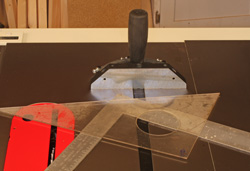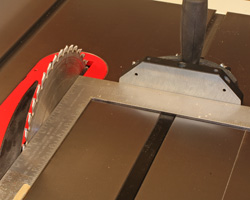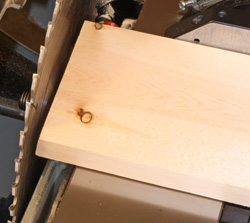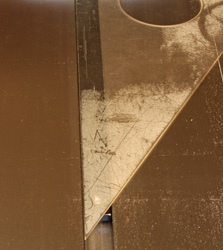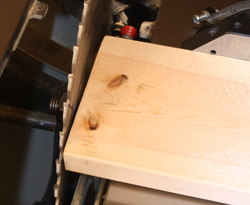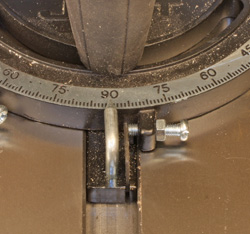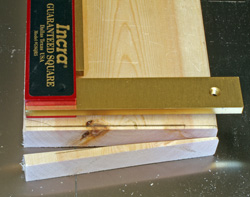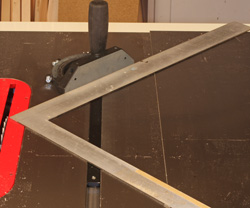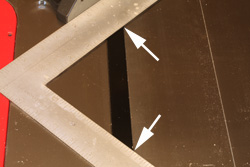This is a Veteran Owned site
 |
||||||||||||||||||||
Squaring Your Miter Gauge the Right Way
The Miter Slot is The KeyText and photos by Tom Hintz Updated - 6-30-2011 Note: The procedure described here in no way circumvents the proper alignment procedures for your table saw blade and fence systems. The manufacturer of your equipment will provide specifications and procedures to keep your equipment properly aligned for both safety and performance. Questions regarding the alignment of table saw miter gauges are very common at NewWoodworker.com. As is often the case, the answer is relatively simple, though not always obvious. Get On the Right PathThe key to producing square cuts with a miter gauge is using the slot in which it slides as the reference, not the blade. Despite our best efforts, the blade is seldom exactly parallel to the miter slot. Referencing the miter gauge to a blade that is out-of-line, even a small amount simply reproduces that error. Over the course of a project, that error accumulates with each cut, making it virtually impossible to build a project that is truly square.
To use the blade as the reference we would have to alter the position of the miter slot itself, not the fence on the miter gauge that slides within it. Even then, the miter gauge would have to be squared to the slot or the cuts will not be square. If we align the miter gauge to the miter slot, the cut will be square to the miter gauge fence and the edge of the wood resting against it. This is because the miter gauge moves the wood along a path controlled only by the miter slot. If the miter gauge is not square to that path, the cut cannot be square. If the blade is slightly out of square to the miter slot, the width of the kerf will be slightly wider, but the cut will be square because the miter gauge moves the wood in a straight line. The increase in kerf width is usually in the thousandths of an inch range if blade alignment is within the manufacturers tolerance. CovingSome argue that if the blade is even slightly out-of-line with the miter slot, aligning the miter gauge to the slot will produce a coved cut. While this is true, the same thing will happen if the miter gauge is aligned with an out-of-line blade. The wood still follows the path of the miter slot, but if the blade is used as the reference, the wood is already at an angle when it meets the blade. This could increase the amount of coving, not reduce it.
We have to be realistic about the tolerances we are working with. The actual amount of cove caused by a slightly out-of-line (within manufacturer tolerance) blade is all but impossible to see or measure with tools commonly used in woodworking. If coving reaches a level of severity to cause problems during glue-ups, (arching the boards under clamping pressure) you probably have serious blade alignment problems that need to be addressed. Aligning the Miter GaugeIf the guide bar of your miter gauge has provisions for adjusting its fit to the slot, do that first. The goal is as little side-to-side movement as possible, but the miter gauge must slide freely in the slot throughout its range of travel. A miter gauge that sticks or binds in its slot is an accident waiting to happen. If your miter gauge is excessively loose in the slot, many woodworking supply houses carry UHMW (Ultra High Molecular Weight) tape that can be applied to one side of the slot to act as a spacer. I use a 14" artists triangle for aligning the miter gauge because its long straight side is easy to align with the edge of the miter slot. Being able to use 14" of the miter slot edge substantially increases the level of accuracy that can be obtained. The artists triangle is very accurate, very cheap and can be used for many lay out tasks in the shop as well. You can find them in most hobby or art supply stores.
Lay the triangle with its short side against the miter gauge fence and the long 90-degree side along the edge of the miter slot. If the edge of the triangle is parallel to the miter slot over its entire length, congratulations, your miter gauge is aligned and you are done. If not, adjust the miter gauge so the edge of the triangle is perfectly aligned with the edge of the slot from beginning to end. Most artists triangles have a 30-degree side as well. You can check that setting on your miter gauge the same way, only having the angled side of the triangle at the miter slot. If your miter gauge has a separate adjustment for this angle, it can be "zeroed" independently. Lock the adjusters and then re-check to be sure nothing has moved. In most cases, precisely aligning the major settings on a miter gauge will make all other settings on its scale very accurate. Tight 45-Degree MitersWant tighter 45-degree miters for projects like picture frames? Lay the short leg of a quality framing square against the miter gauge fence set at what you believe to be 45-degrees. Align the 5" marks on the INSIDE edge of the framing square with one side of the miter slot and lock the miter gauge at that angle.
If your miter gauge has an adjustable 45-degree stop, this is a great way to set and check that as well. Quick TestA quick way to check your miter gauge (at 90-degrees) is to match up the halves of a cut. You need a board at least 5"-wide and a few feet long with straight, parallel sides. Mark a cut line and then make a large "X" across that line. Place the board on the miter gauge and make a cut on the line. After the saw stops retrieve the pieces and stand them on the edge that was against the miter gauge, both halves of the "X" facing you. With the edge of the board flat on the table and the cut ends held together, look for any gaps in the cut line. Then, flip the cut-off end over so the freshly cut edge remains against the other cut edge, but that half "X" is facing away from you. Again, hold the edges on the table and the cut ends together and check for gaps between the cut edges. If there are none, your miter gauge is cutting at 90-degrees. If you see a gap, re-align the miter gauge as described earlier and test again. I check the alignment of my miter gauge occasionally, and always before operations like cutting the rails of a table frame where a small misalignment accumulates with each successive joint.
Keeping your miter gauge properly aligned helps produce tight joints and projects that come out square. Regardless of skill level, it is usually a number of small errors that accumulate to create major problems. The alignment of your miter gauge is one problem you can fix, and keep fixed. Do you have a comment about this page? - Email Me! Back to the Tips & Tricks List
|
||||||||||||||||||||
All written, photographic and drawn materials are property of and copyright by NewWoodworker.com LLC 2000-2019. Materials may not be used in any way without the written permission of the owner.

